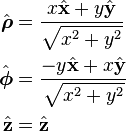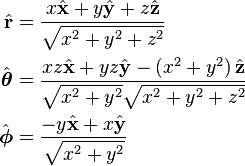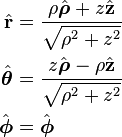Coordinate systems/Derivation of formulas
< Coordinate systemsThe purpose of this resource is to carefully examine the Wikipedia article Del in cylindrical and spherical coordinates for accuracy.
The identities are reproduced below, and contributors are encouraged to either:
- Verify the identity and place its reference using a five em padding after the equation: {{pad|5em}}verified<ref>reference</ref>
- Contribute to Wikiveristy by linking the title to a discussion and/or proof. Just click the redlink and start the page.
If you just came in from Wikipedia, the rules about treating each other with respect and obeying copyright laws remain more or less the same as on Wikipedia, but the definition of what constitutes an acceptable article is a lot looser. Here we call them "resources". Welcome to the wacky world of Wikiversity, where anything goes.
Transformations between coordinates
- w:Cartesian coordinates (x, y, z)
- w:Cylindrical coordinates (ρ, ϕ, z)
- w:Spherical coordinates (r, θ, ϕ)
- w:Parabolic cylindrical coordinates (σ, τ, z)
Coordinate variable transformations*
*Asterisk indicates that the title is a link to more discussion
Cylindrical from Cartesian variable transformation
 ,
,  ,
,  verified using mathworld[1]
verified using mathworld[1]
Cartesian from cylindrical variable transformation
 ,
,  ,
,  verified using mathworld[2]
verified using mathworld[2]
Cartesian from spherical variable transformation
 ,
,  ,
,  verified using mathworld[3]
verified using mathworld[3]
Cartesian from parabolic cylindrical variable transformation
 ,
,  ,
,  --no reference
--no reference
Spherical from Cartesian variable transformation
 ,
,  ,
,  verified using mathworld[4]
verified using mathworld[4]
Spherical from cylindrical variable transformation
 ,
,  ,
,  no reference
no reference
Cylindrical from spherical variable transformation
 ,
,  ,
,  no reference
no reference
Cylindrical from parabolic cylindrical variable transformation
 ,
,  ,
,  no reference
no reference
Unit vectors
Cylindrical from Cartesian unit vectors
 Verified, see page linked in title
Verified, see page linked in title
Cartesian from cylindrical unit vectors
 Verified, see page linked in title
Verified, see page linked in title
Cartesian from spherical unit vectors
 Verified, see page linked in title
Verified, see page linked in title
Parabolic cylindrical from Cartesian unit vectors

Spherical from Cartesian unit vectors
 Verified, see page linked in title
Verified, see page linked in title
Spherical from cylindrical unit vectors

Cylindrical from spherical unit vectors

Vector and scalar fields
 is vector field and f is a scalar field. The vector field can be expressed as:
is vector field and f is a scalar field. The vector field can be expressed as:
Gradient of a scalar field
 is the w:gradient of a scaler field.
is the w:gradient of a scaler field.
Divergence of a vector field*
 is the w:divergence of a vector field
is the w:divergence of a vector field
Curl of a vector field
 is the w:curl (mathematics) of A
is the w:curl (mathematics) of A
Laplacian of a scalar field
 is the w:Laplace operator on a scalar field
is the w:Laplace operator on a scalar field
Laplacian of a vector field
 is the w:Vector Laplacian of
is the w:Vector Laplacian of 
Material derivative of a vector field
 might be called the "convective derivative of B along A" (appropriate description if A' is a unit vector) [5]
might be called the "convective derivative of B along A" (appropriate description if A' is a unit vector) [5]
Differential displacement
Differential normal areas
- These vector differentials cannot be integrated for curved surfaces. Click the title above to see why.
Differential normal area 
Differential volume
nabla's on nabla's
Non-trivial calculation rules:
-

-

-

-
 (Lagrange's formula for del)
(Lagrange's formula for del) -

References
- ↑ http://mathworld.wolfram.com/CylindricalCoordinates.html
- ↑ http://mathworld.wolfram.com/CylindricalCoordinates.html
- ↑ http://mathworld.wolfram.com/SphericalCoordinates.html
- ↑ http://mathworld.wolfram.com/SphericalCoordinates.html
- ↑
- ↑ James Stewart, Calculus: Concepts and Contexts, fourth edition, Brooks Cole 2005 pp. 884-5
- ↑ James Stewart, Calculus: Concepts and Contexts, fourth edition, Brooks Cole 2005 pp. 884-5
- ↑ James Stewart, Calculus: Concepts and Contexts, fourth edition, Brooks Cole 2005 pp. 884-5
- ↑ Weisstein, Eric W. "Convective Operator". Mathworld. Retrieved 23 March 2011.
- ↑ Huba J.D. (1994). "NRL Plasma Formulary revised". Office of Naval Research. Retrieved 11 June 2014.
Backup copy from Wikipedia
Copy or read but never change Original Copy from Wikipedia
















































